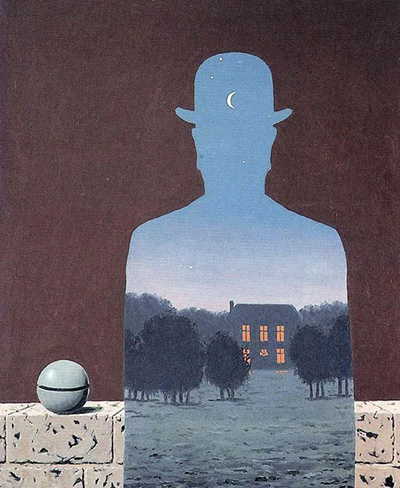Rene Magritte's 'The Happy Donor' was completed in 1966, not long before the artist's death of cancer in 1967. The work employs a number of Magritte's typical symbols, including the use of a man in a bowler hat as the painting's protagonist.
As is usual with an artist of surreal sensibilities such as Magritte, the work is far from being a simple portrait. The shape of the man in the bowler hat is filled with a pleasing, yet slightly eerie, image of a home in what looks to be a large garden. The lights in the home are blazing, while the house's setting is somewhat grey and misty, as though viewed through a lens which opens into another reality.
The man in the bowler hat seems himself to be anchored in another world. He is standing up against a small wall, pitted and scarred with incisions into its white bricks. A plain sphere, with a ridge running along its equator, stands on the wall. In the man's head is a crescent moon, which looks down over the house. This adds to the sense of a dream landscape in the work, with the moon often used as a symbol of insanity in wider culture.
The painting echoes a number of Magritte's other works from this later period of his career. Other works such as the 'The Pilgrim' and 'Decalcomania', also produced in 1966, both use the image of the bowler-hatted man, with variations. Magritte seems to be exploring, once again, the magic that binds art to reality. The moon, as well as often being used a symbol of insanity, is also often incorporated in the iconography of magic. In children's stories, a wizard is often depicted with crescent moons on his garments.
Magritte seems to be saying that dreams and art, magic and insanity, lie within us all, even men in bowler hats. The key to life, and art, is how that magic can be unlocked, how the dreams that we all have, lie within, pointing the way to artistic fulfilment, if we would just let them.




